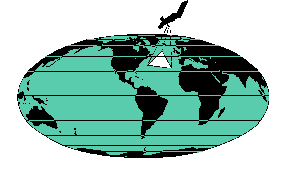 ©2020 Biological and Chemical Oceanography Data Management Office.
©2020 Biological and Chemical Oceanography Data Management Office.Funded by the U.S. National Science Foundation
There were no cruises associated directly with the US JGOFS SMP. The SMP deployment refers to the project being deployed.
The Joint Global Ocean Flux Study (JGOFS) was an international scientific program devoted to the study of the ocean biogeochemistry of carbon and related elements and the linkages of the ocean with the global carbon cycle. The U.S. JGOFS program involved a decade long, intensive field effort that included: two on-going time-series stations off Hawaii and Bermuda; a series of process studies in the North Atlantic, Equatorial Pacific, Arabian Sea, and Southern Ocean; and a Global Ocean CO2 Survey in conjunction with the World Ocean Circulation Experiment (WOCE). The resulting ocean biogeochemical data sets, together with satellite ocean color data from the NASA Sea-viewing Wide Field-of-view Sensor (SeaWiFS), formed a unique, long-term resource for the ocean community. With the completion of the field phase in the late 1990s, the U.S. JGOFS initiated a final Synthesis and Modeling Project (SMP), to build on and integrate these data sets in order to address the key scientific themes of JGOFS:
Specifically, the central objective of the SMP was to synthesize knowledge gained from U.S. JGOFS and related studies into a set of models to reflect the current understanding of the ocean carbon cycle and its associated uncertainties (U.S. JGOFS, 1997). The SMP was tasked to address not only the processes that control carbon partitioning among oceanic reservoirs, but also the implications for ocean/atmosphere carbon exchange. Both data synthesis and modeling proposals were encouraged with an emphasis on coordinated interaction between the two. The major elements of the program included:
The SMP became a full fledged program with the funding of the first SMP awards in early 1998. Funding for SMP grants was provided by the National Science Foundation (NSF), the National Aeronautical and Space Administration (NASA), the National Oceanic and Atmospheric Administration (NOAA), and Department of Energy (DOE).
Specific projects within the SMP fell into two broad categories: data synthesis and extrapolation, and modeling. There was considerable (and necessary) overlap between the two, and the overview of the projects provided below is certainly a simplification of the collective efforts of the individual researchers (details on individual SMP grants can be found at http://usjgofs.whoi.edu/mzweb/syn-mod.htm). The scope and balance of the SMP was based on geographic region of study and investigation of biogeochemical processes.
The U.S. JGOFS SMP continued through the 2003-2004 time frame. As the program matured and specific initial projects were completed, the foci for the program was refined to emphasize both emerging new scientific directions and remaining unfinished elements of the original implementation plan. The SMP together with the U.S. JGOFS Steering Committee periodically assessed the program with regard to future priorities. During the active research phase, these are some of the topics identified as filling critical gaps for SMP science:
At the local to regional scale, a series of data synthesis and food web modeling investigations explored aspects of euphotic zone production, recycling, export, transport and remineralization, and sediment cycling using the JGOFS process and time-series data base and related data sets. Individual projects concentrated, for example, on subsets of the overall JGOFS data (e.g. bacteria, mesozooplankton, HPLC pigments). Related projects focused on the distribution and dynamics of planktonic functional groups (e.g. N2 fixers, diatoms, calcifiers). The eventual aim of many of these food web related studies was to extrapolate the findings to basin and global scale and/or to develop improved process-based parameterizations that could be incorporated into regional and global models.
One or more regional ecosystem modeling studies were undertaken for each of the following U.S. process/time-series study locations: Equatorial Pacific and Atlantic, Arabian Sea, Ross Sea, Bermuda, and North Atlantic. Additionally, there were four projects which concentrated on data synthesis and/or modeling for various continental margins: NW Atlantic margin, southern Caribbean, Cariaco Basin, and several coastal upwelling regions. The regional synthesis and modeling studies as well as some of the food web projects relied heavily on satellite data. Many SMP projects utilized satellite data, in particular SeaWiFS ocean color, as an integral part of both model evaluation and time/space extrapolation.
On the global perspective, over a dozen synthesis groups worked on the JGOFS/WOCE global CO2 survey data with good coverage for all of the carbon related parameters (DIC, alkalinity, 13C, 14C, nutrients, oxygen, pCO2, etc.). A coordinated global biogeochemical modeling effort was initiated as part of the international Ocean Carbon Model Intercomparison Project (OCMIP, http://www.ipsl.jussieu.fr/OCMIP/). As the name implies, this was an observation-based evaluation of some thirteen global ocean biogeochemical models of the natural and anthropogenic inorganic carbon system, biogeochemical fields (nutrients, oxygen), and related passive chemical tracers (e.g. CFCs, 14C, 3He).
Ocean Carbon & Biogeochemistry (OCB)
North American Carbon Program (NACP) Coastal Synthesis

Lead Principal Investigator: Scott Doney
Woods Hole Oceanographic Institution (WHOI)
Co-Principal Investigator: Jorge Sarmiento
Princeton University
Contact: Mary Zawoysky
Woods Hole Oceanographic Institution (WHOI)
BCO-DMO Data Manager: Cynthia L. Chandler
Woods Hole Oceanographic Institution (WHOI)
U.S. Joint Global Ocean Flux Study [U.S. JGOFS]